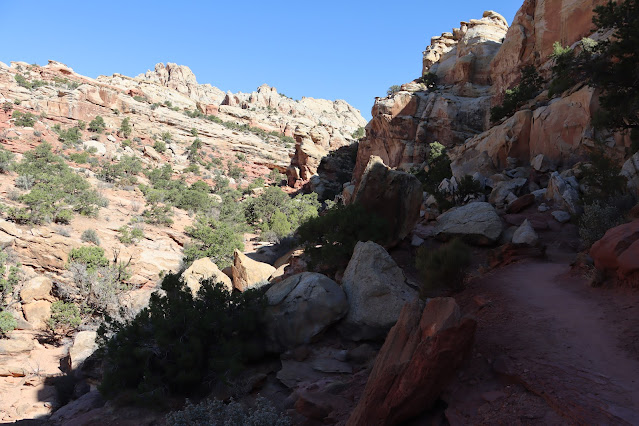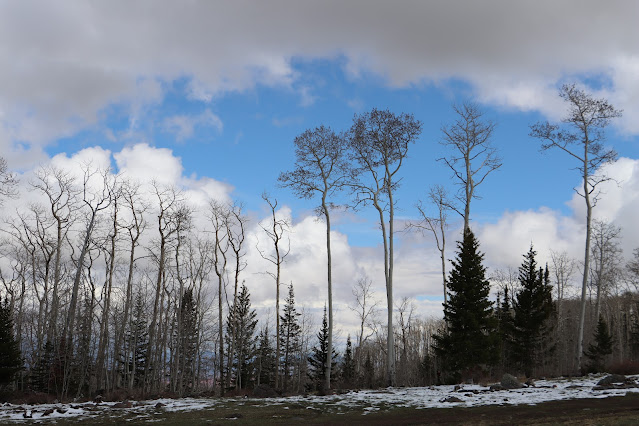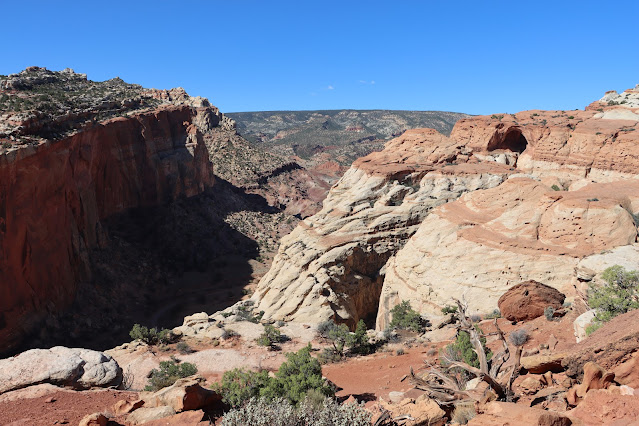In a season of disrespect, defunding, and outright selling of public lands, I offer this homage to three wonderful days of exploring the beautiful public lands of Southern Utah. May they ever be protected and cared for.
I started my three-day trip at the tail end of a two-day rainstorm. By the time I arrived in Kodachrome Basin State Park to the southeast of Bryce Canyon National Park, the storms had subsided, and I was greeted with a cool, cloudy day perfect for a few hours of hiking. Sad to say for this Utah native, but this was my first time visiting. I'm glad I finally came.
The name of the state park has always intrigued me. When I set off for my Mormon mission to Indonesia in 1975 my dad outfitted me with a Pentax camera and rolls and rolls of 36 exposures Kodak Kodachrome slide film. Dad told me that it had the best and longest lasting color. He was right. I used Kodachrome slide film almost exclusively until digital photography arrive. Many of the slides from Indonesia and my other travels were used year after year in my geography class slide shows and the vibrant, realistic colors never faded.
From a Wikipedia article of Kodachrome Basin:
In 1948 the National Geographic Society explored and photographed the area for a story that appeared in the September 1949 issue of National Geographic. They named the area Kodachrome Flat, after the brand of Kodak film known for its vibrant color rendition.[6] In 1962 the area was designated a state park. Fearing repercussions from the Kodak film company for using the name Kodachrome, the name was changed to Chimney Rock State Park, but renamed Kodachrome Basin a few years later with Kodak's permission.[6]
I first hiked the panorama Trail loop including the Secret Passage and Panorama Point. Second hike was Angel's Palace.
Look like handprints in playdough, but it's carved into hard sandstone.


Secret Passage


View from Panorama point eastward.
View from Panorama point westward towards Bryce Canyon.
Narrow end of a trail.
I had hoped to drive out to see Grosvenor Arch, but the nice ranger in the state park advised against it explaining that with the recent rains the soft clay and sandy road would be treacherous, and I would more than likely get stuck. Stayed the night in Escalante.
One of my favorite drives is Highway 12 from Bryce Canyon to Capitol Reef.
Much of that road traverses Grand Staircase-Escalante National Monument (established 1996). A few years ago, on a family outing we hiked to the upper falls on Calf Creek just off Highway 12 between Escalante and Boulder
https://beitemmett.blogspot.com/2020/07/roads-less-travelled-by-upper-calf.html. For this trip I decided to hike to the more popular lower falls on Calf Creek. It was a spectacular hike.
It was a six-mile round trip hike along the flowing stream of Calf Creek. Along the way there were pictographs, hill side granaries and bever ponds to be seen. As I walked, I talked with people from points all over: two groups from Australia, plus folks from Washington, North Dakota, Virginia and New Jersey. I was one of the first cars in the parking lot when I arrived around 8:30 but it was overflowing four hours later when I returned.
Once under the supervision of the Bureau of Land Management (BLM), now a part of Grand Staircase-Escalante National Monument.
Calf Creek dropping out of the north into the wider Escalante River valley.
Pictograph of three beings.
They are in the bottom center of the large smooth rock face.

More beaver dams and ponds.
Lots of swallows and fish feeding on flying insects.
Beautiful cliff faces streaked with desert varnish.

I've always been a big fan of plaid (gotta be my Scottish roots showing), but I have never considered that plaid might be nature-made too. The coming together of the horizontal and vertical stripes makes a striking southern Utah plaid.
Trees trying it too.
Still no beavers to be seen.
Pictographs with a little less shade.
More desert varnish plaid.
Somewhere on this cliff face are several granaries of the Fremont culture.
Next time I'll bring binoculars to see if I can spot them.
Looking down into Calf Creek Canyon from the heights of Highway 12.


Looking north across the farms and fields of Boulder to snowcapped Boulder Mountain. The drive up and over Boulder Mountain to Torrey and Capitol Reef travels through some amazing Aspen forests.

This 1983 map shows Dixie National Forest land in Green, BLM land in yellow (much of which is now GSENM), Capitol Reef NP is purple, white is private lands--mostly small agricultural towns like Escalante and Boulder in the lower right quadrant. These towns once relied more on forestry, ranching and resource extraction, but now are more tourism based. The blue is state land--mostly the scattered squares of school trust lands. When Grand Staircase was created school lands within the protected area were exchanged for federal lands (national forest and BLM lands) elsewhere making more concentrated parcels of school trust lands to the north and west of Dixie National Forest.
Highway 12 over Boulder Mt can be seen running north to south on the eastern/right side of Dixie National Forest between the white colored areas of Boulder (center right) and Torrey (top right)
Views from and on Bouder Mt.


Once in Capitol Reef I headed to the Gifford House but they were sold out of pies. Instead, I walked past the remnant orchards and trees from the early Mormon settlement of Fruita along the Fremont River trail and up to a lookout point.
Fremont River

Looking northward from the trail end back to the orchards and park center at Fruita.
After a night in nearby Bicknell, I drove back to the park and up the Grand Wash to the trail head parking for my morning hikes up to Cassidy Arch and then up the Grand Wash to the Narrows

The Grand Wash, still in shade.
It was a steep rocky climb up out of the wash to the upper shelf where Cassidy Arch was located.


Thanks to the many national park employees who maintain such a nice trail with impressive stair work.
The trail follows the shelf about mid way up the face on the left.
I got a spot in the trail head parking lot. Two hours later and cars were parked all along the road
First view of the arch--top right corner.
The only way to get to the base of the arch is to repel down. Most people like me chose to just walk out on the top.
The arch is on the left face of the big red sandstone field in the center of the photo.
More from Wikipedia:
Cassidy Arch is named after local railroad bandit Butch Cassidy, who reportedly had a hideout in nearby Grand Wash Canyon while on the run.
Glad to have my hiking poles to help spare my knees on the steep hike down via well-made and cared for stairs and trails.
Three miles round trip from the turn off in Grand Wash.
I surprised myself and still had enough get-up-and-go to hike furthur into the Grand Wash. It was about a mile to the narrows where I turned around. Our family hiked into Grand Wash from the other end on Highway 24 to near the beginning of the narrows on our pandemic road trip but turned back before getting to the Narrows because of a rainstorm.
Lunching squirrel.
I lunched in the shade of this overhang.
Cassidy Arch from the Grand Wash Road.
Information about uranium mining in the Capitol Reef area and questioning the need to extract resources from such a beautiful landscape. This issue tied in nicely to an amazing book I had been listening to as I drove and hiked.
Here is a summary from the publisher:
In May 2016, Fort McMurray, the hub of Canada’s oil industry and America’s biggest foreign supplier, was overrun by wildfire. The multi-billion-dollar disaster melted vehicles, turned entire neighborhoods into firebombs, and drove 88,000 people from their homes in a single afternoon. Through the lens of this apocalyptic conflagration—the wildfire equivalent of Hurricane Katrina—John Vaillant warns that this was not a unique event, but a shocking preview of what we must prepare for in a hotter, more flammable world.
Fire has been a partner in our evolution for hundreds of millennia, shaping culture, civilization, and, very likely, our brains. Fire has enabled us to cook our food, defend and heat our homes, and power the machines that drive our titanic economy. Yet this volatile energy source has always threatened to elude our control, and in our new age of intensifying climate change, we are seeing its destructive power unleashed in previously unimaginable ways.
With masterly prose and a cinematic eye, Vaillant takes us on a riveting journey through the intertwined histories of North America’s oil industry and the birth of climate science, to the unprecedented devastation wrought by modern forest fires, and into lives forever changed by these disasters. John Vaillant’s urgent work is a book for—and from—our new century of fire, which has only just begun.
As I hiked along Calf Creek and up to Cassidy Arch and drove over Boulder Mountain, I couldn't help but think about how the extraction and use of resources, primarily fossil fuels, has changed our world for both our betterment (think rare metals for our cel phones or gas for our cars) and to our detriment (think global warming and hotter and bigger fires that have wiped out Fort McMurray, Lahaina and Palisades). I also thought about recent efforts to defund National Parks and to fire their guardians, about executive orders rolling back environmental protections, and about legislation seeking to sell off public lands. It all saddened me, not just because I fear that the beauty I experienced over three days in Southern Utah may not remain protected and may not survive ever increasing climate volatility, but because we (collectively as humans) don't care enough about this world to treat it and us better.
I finished my stay in Capitol Reef with a stop at the Gifford House for some homemade Strawberry Rhubarb pie. And a bottle of cherry jam to take home.
The world will have some hell fire days ahead, but in the meantime, I'll at least enjoy some homemade pie and wading in the cold water of a red rock stream. I'll also work to save public lands and to do my part in stemming global warming.


















































.jpg)



































































.jpg)






























































